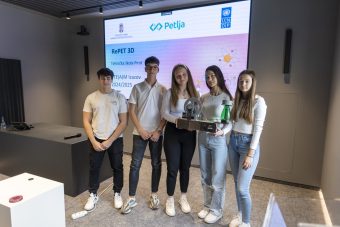A truly conscious relationship toward nature preservation is developed through upbringing, education, and the active involvement of children in ecological initiatives. At the Technical School in Pirot, Professor Bojan Ćirić, in the role of mentor, led a team of motivated and talented students in a research and innovation project that combines ecology, engineering, and modern technologies. When a school becomes a place where teachers not only pass on knowledge but also encourage responsible action and leave space for independent exploration and creation, ideas like RePET3D are born – a team that connects knowledge, sustainability, and innovation into a concrete solution for the problem of plastic waste.
Each student contributes to the project in accordance with their interests and abilities, says Professor Ćirić, adding that he and his colleague, Bojan Blagojević, as mentors, strive to support the students through expert guidance, encouragement of creativity, a research spirit, and independent problem-solving. Their goal is not only to teach them skills but also to empower them to become responsible and socially engaged young individuals.
“RePET3D is an example of how a school can be a place where ideas are born that have a real, tangible impact on the community,” says Professor Ćirić.
IN FOCUS:
- GreenCleanS as a Response to the Environmental Challenges of Oil Regeneration
- Sustainability as a Strategic Priority
- A Market Driving the Transition: Seepex at the Heart of a New Energy Era
The RePET3D Project
At the center of the project is a device conceived and developed by the mentors in collaboration with the students, which enables the mechanical processing of used PET bottles – precisely cutting them into strips, thermomechanically treating them, and converting them into standardized filament that can be used in commercial 3D printers. During the development process, students were involved in all stages – from research and mechanism design to prototype creation, testing, and device refinement. That process gave them valuable experience in solving real-world problems through teamwork, creative thinking, and the application of knowledge from physics, engineering, IT, and ecology.
The solution they developed has broad application – it is used both as an educational tool and a practical means for reducing plastic waste. Regarding its educational purpose, the professor highlights that the device is planned to be used in both regular and project-based instruction, as a tool through which students can practically learn about recycling processes, technical drawing, mechanics, and working with 3D printers. The device also allows them to independently produce filament and use it to create various models, thus encouraging creativity, practical skills, and an exploratory approach to learning. Practically speaking, the system operates as a mini-recycling plant within the school, enabling students to contribute to environmental preservation actively.
“Our goal with this project is to show how education can be a driving force for concrete and sustainable solutions to modern problems,” says Professor Ćirić.

During the implementation of the RePET3D project, students faced numerous challenges that required persistence, teamwork, and creative problem-solving. The greatest challenge was developing a functional device for converting PET bottles into filament, which involved solving technical issues such as material selection, temperature control, determining the optimal cutting speed, and ensuring the mechanical stability of the device. In addition to technical obstacles, organizing teamwork played a crucial role, involving task allocation, idea coordination, and mutual collaboration. Through experimentation, error analysis, and mentor support, students developed not only technical skills but also communication, tolerance, and a sense of responsibility.
According to the professor, projects like RePET3D have great potential to influence the development of ecological awareness among students and the community. Through active involvement, students didn’t just learn about recycling – direct participation in the process changed the way they perceive waste: not as a problem, but as a resource that can be used in creative and useful ways. The project also encouraged the broader community to participate by donating packaging, showing interest in the results, and spreading awareness about recycling and reuse.
Prepared by: Katarina Vuinac
The story was published in Energy portal Magazine PURE ENERGY

